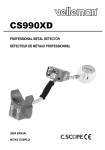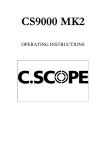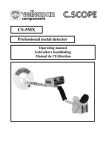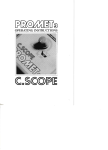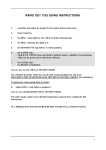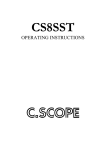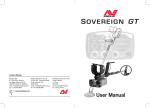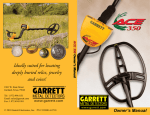Download C-SCOPE XD Instruction manual
Transcript
CS1220XD - RAPID GET YOU GOING INSTRUCTIONS Assemble and adjust for length (Twist surplus lead around stem). Insert batteries. Set the MODE SELECT (bottom right) to METER AUDIO DISC. Set POWER ON/OFF TUNE (top left) to ON. Set SENSITIVITY fully anticlockwise to the BATTERY CHECK position. The meter will indicate in the right hand green sector if the batteries are OK. Set SENSITIVITY to mid position (12 o’clock). With the search head 1-2 cm from the ground, press and hold the RETUNE button (lower mid) and adjust the TUNE control until a tone is just heard. Release the RETUNE button. The CS1220XD is now ready for use. If the tone drifts from the threshold position press the RETUNE button to reset the level. You are now in a PROGRAMMED MODE. The other modes require more detailed explanation found in the following pages. IF A PROBLEM IS ENCOUNTERED REFER TO THE FULL INSTRUCTIONS. 1 CONTENTS: PAGE INTRODUCTION ASSEMBLY BATTERIES BATTERY CHECK CONTROLS AND WHAT THEY DO METHODS OF OPERATION GENERAL HINTS ACCESSORIES (OPTIONAL) AVAILABLE FROM C-SCOPE CHARGING BATTERIES THE IMPORTANCE OF THE RIGHT APPROACH SWEEPING TECHNIQUE METAL DETECTING AND THE ENGLISH LAW CODE OF CONDUCT FOR METAL DETECTOR USERS CARE OF YOUR DETECTOR TROUBLESHOOTING 2 4 4 4 5 6 9 13 15 16 16 17 18 19 19 20 Controls C-Scope CS1220XD A B C D E A B C D E F G H I J K L M N O Battery Compartment Upper Stem & Handle Grips Din Plug & Socket Stem Connecting Nut Cable Lower Stem Search Head Fastener Power On / Off Tuning Signal Meter Sensitivity Discrimination Ground Select Retune Discrimination Select Function F G 3 INTRODUCTION To protect your investment complete both sections of the enclosed guarantee card and return to C-Scope. This is particularly important in order to obtain the free second year parts guarantee. Please retain the original packing box. In the event that your detector should ever require to be serviced, this package will be most suitable for postal protection. C-Scope detectors are recognised as the finest detectors available. They are designed with lasting quality, high technology, and above all, value for money. The only way to realise this value is to carefully study and understand this instruction manual. You will then be able to obtain all the advantages designed into your detector. It is also strongly recommended that you experiment with the detector's operation in air using various test samples, in order to learn to identify and understand the detector's capabilities and responses. Always remember that becoming a good metal detectorist is like becoming a good photographer or fisherman, that is, although it is an advantage to buy the best equipment, having bought it, patience and hours of practice are needed to become proficient. ASSEMBLY Open the carton and remove the main housing assembly. Twist the plastic stem lock, located at the end of the upper stem to allow the lower stem to be inserted. Adjust for length and rotate the lower stem to wrap the cable around the stems and take up any slack. Allowing enough cable for free movement of the search head push the cable into the cable slots to hold it firm. Turn the stem lock to fix it at the desired position. BATTERIES The CS1220XD is powered by eight AA batteries (not supplied) available from garages, department stores, etc. or a single 12v rechargeable pack from C-Scope. It is advisable to use standard alkaline batteries to start with. You can then evaluate the sort of use you give the detector and decide whether the investment in rechargeables is justified. Battery Compartment CHARGER SOCKET HEADPHONE SOCKET BATTERY COMPARTMENT The batteries should be fitted in the 4 holder which is located in the battery compartment. To fit new batteries first check the power switch on the unit is switched to OFF. Then loosen the two captive screws located in the battery cover (do not fully remove these from the cover) and remove the cover. Inside is the battery holder. Lift out the holder and detach the connector if it is already fitted. Load it with the eight batteries ensuring that each battery is inserted the correct way round, (direction of batteries alternating). Roll each individual battery to ensure it is located correctly and making proper contact. Replace the connector making sure that it is firm and well seated, and put the loaded holder into the housing. Fit the cover and tighten the two captive screws finger tight. Note: Zinc Carbon batteries should not be left in the detector for long periods where they could leak, so remember to remove them at the end of a day's searching. BATTERY CHECK A battery condition indicator is provided on the detector. To do this for the first time prior to reading the remainder of the operating instructions proceed as follows:- Turn the POWER ON/OFF, TUNE control on. Turn the SENSITIVITY control fully anti-clockwise to the BATTERY CHECK position. The meter will indicate in the green area if the batteries are good and in the left or central position if the batteries need replacing or recharging. Rechargeable batteries will not read as high into the green as standard batteries even when fully charged. They also give less indication of discharge on the meter during use. Checking The Batteries 5 CONTROLS AND WHAT THEY DO 1. 2. 3. 4. On/Off Tune Sensitivity/Battery Check Function/Mode Select control Discriminate Push Select button 5. 6. 7. 8. Retune button Ground Push Select button Discrimination Signal Meter Power On/Off Tune Switch (1) This rotary control switches the detector on and adjusts the level of audio tune to the user’s preference and the level of meter tune when in the Manual Control modes (see below). Sensitivity/Battery Check (2) In the fully anticlockwise switched position the Battery Check is enabled with the battery condition displayed on the meter (8). When turned clockwise the control will adjust the sensitivity of the detector to metal objects. By increasing the sensitivity by tuning this control clockwise, the detector will be more prone to drift, erratic signals, ground interference etc. Where there is no ground effect or outside interference the SENSITIVITY control can be operated at higher levels. When the signal becomes unsteady or erratic, the sensitivity level should be reduced to obtain a clear, steady tuning threshold. Only when the tuning is constant and steady will the detector operate at the optimum depth penetration. The recommended starting point is midway, i.e. “12 O’clock” position. 6 Function Switch (3) This rotary switch selects the Pre-programmed modes Meter Audio Disc and Meter Disc or the Manual Control modes GD1 and GD2. When set to either METER DISC or METER AUDIO DISC, the levels of Discrimination or Rejection are identical (Discrimination can be defined as the ability to give a different type of signal for ferrous junk or worthless objects than the signal given by a non-ferrous object). Both these Discriminate Modes are set at such a level, so that depth penetration to coins etc. is good, and discrimination against most iron and silver foil is achieved. A precise level of discrimination is selected to give maximum rejection, without affecting sensitivity to coins etc. Pull tabs, large silver foil, or large iron will not be rejected, because the levels of discrimination required to reject these also reduce the depth penetration to certain non-ferrous metals and thin section objects. It is very unlikely that a valuable object will be rejected with the CS1220XD’s AUDIO or METER DISCRIMINATION modes. Meter Audio Disc Mode In this mode, the Meter (8) will display rejected targets by the needle moving to the left of central. Positive targets, i.e. those likely to be worthwhile digging for, are indicated by no needle movement or a deflection to the right of centre. The Audio signal will also vary in pitch providing further analysis of the target. An increase in pitch (high tone) is a good object and a decrease in pitch (low tone) is a bad object. In summary Meter Audio Disc is target analysis using both Meter and Audio signals. Meter Disc Mode In this mode the Meter (8) will display rejected targets by the needle moving left of centre and good targets by not moving or moving to the right of centre. The audio signal will be at a fixed pitch whatever the target composition, only the loudness will vary depending on signal strength. In summary Meter Disc is target analysis using the Meter for metal content and loudness to indicate target size or depth. The Manual Control Modes, GD1 and GD2 In the Manual Control Modes the detector utilises one of two circuits. One is for optimisation against unwanted Ground signals and one is for Discriminating against unwanted targets. Ground G The ground signals are due to the natural mineral deposits or contamination e.g. carbon or slag left from industrial processes. The circuit to ignore the ground signals is preset during 7 manufacture at the optimum level. The level is the same in switch positions GD1 and GD2. Discriminate D1 & D2 The Discriminate circuit can be set to the range GD1 or range GD2 using the FUNCTION switch. Range GD1 allows the user to select the level of Discrimination from iron to small silver foil. Range GD2 allows variation from silver foil, through pull tabs to screw caps. Discriminate push button (4) / Discriminate rotary control (7) These two controls are enabled in Manual Control Modes GD1 and GD2 only. The variable Discriminate level is adjusted by first selecting the DISCRIMINATE mode by push button (4) then rotating the level control (7). The level of Discriminate can be adjusted for each Discriminate mode by operating the DISCRIMINATE LEVEL control on the Main Control Box. i.e. GD1 - Discriminate level 0 GD1 - Discriminate level 10 GD2 - Discriminate level 0 GD2 - Discriminate level 10 - No discrimination - Iron and silver foil discriminate - As D1 discriminate 10 - Iron, silver foil and pull tab discriminate Warning! If the detector is set to GD2 and discriminate level 10 then as well as rejecting pull tabs, some copper nickel coins and gold rings etc. will be rejected at these severe settings. Copper and solid silver or gold will be detected though. Generally, only set the detector to D2 - 10 on sites where the incidence of pull tabs makes detecting impossible otherwise. The audio volume will decrease when a ‘bad’ target is identified and increase for a ‘good’ target. Retune (5) This push button resets the level of tune to the level initially set by the user. 8 Ground (6) This push button is operative in Manual Control Modes GD1 and GD2 only. It sets the detector for operation in most types of ground conditions and removes the requirement to keep the search head the same distance from the ground while searching. All metals will give a ‘good’ or ‘positive’ signal when the Ground mode is selected. Meter (8) The meter will display the following:i) battery condition - when Battery Check is selected ii) target analysis to preset levels - when Meter Audio Disc or Meter Disc are selected iii) target analysis to user set Discriminate level - when GD1 or GD2 are selected and the Discriminate mode operational. iv) Signal strength - when in GD1 or GD2 and the ‘all metal’ Ground mode. METHODS OF OPERATION There are two main ways to use the CS1220XD: 1) Pre-programmed searching - for ease of use 2) Manual settings - for total flexibility on all sites Check the batteries are in good condition prior to searching. Frequently the check battery condition during the search. Rechargeables give little warning of failure so ensure they are fully charged prior to a long period of searching or carry a fresh set with you (see batteries page 4). The unit may operate with reduced sensitivity for a period after indicating ‘flat’ batteries. However, the batteries should be replaced or recharged at the first opportunity. Use headphones when possible. Not only do they extend battery life, but they also cut out extraneous noise. 9 Pre-programmed Modes There are two pre-programmed modes provided: i) Meter Audio Disc ii) Meter Disc Meter Audio Disc This is the recommended mode when starting to use the CS1220XD and is best demonstrated by an air test (with the search head away from ground and all metal objects). Turn the FUNCTION control (3) to METER AUDIO DISC (fully clockwise) and adjust the SENSITIVITY control (2) to mid-position. Turn the detector ON at the POWER ON/OFF TUNE control (1) which works in conjunction with the RETUNE button (5). Hold the RETUNE push button down, and rotate the TUNE control clockwise until the sound is just beginning to be audible. Set this carefully and precisely and then release the RETUNE push button. If the tuning level alters or wanders off tune, do not adjust the TUNE control. Simply operate the RETUNE push button which will automatically re-tune the detector to the original selected level. The meter needle should be central when the RETUNE push button is released. The detector is now excluding ground minerals at a pre-set level and discriminating at a preprogrammed level on the other channel. All metal objects will be indicated by an increase in loudness but rejected objects will cause the meter to fall to the left and the tone frequency to decrease. Accepted targets will conversely cause the meter to rise to the right or remain stationery and the tone frequency to increase. Pre-programmed Meter Audio Disc Method of Operation Set Controls as Follows In this mode, the DISCRIMINATE controls and the GROUND control are not enabled. Searching 10 Tune the detector with the search head 1-2 cm above the ground. Sweep the detector in an arc, ensuring the head is level and as close to the ground as possible. Advance half a head length at a time. Periodically ensure the tune level is correctly set by raising the head 1-2 cm, depressing the RETUNE push button, then lowering the head and continuing the search. When searching satisfactorily the SENSITIVITY control can be adjusted up to obtain the optimum setting for the conditions (it will be necessary to retune the detector when this is done). Meter Disc This mode is similar to operate to the Meter Audio Disc. The only difference is the way the CS1220XD responds to metal objects. All detected metal objects will be indicated by an increase in loudness. The meter will indicate whether the target is accepted or rejected. In this mode the audio pitch is constant. Manual Control Modes There are two manually set modes set by the FUNCTION switch. i) GD1 ii) GD2 The operation is the same for both modes. Initially GD1 or GD2 is selected. For a low to mid range of Discrimination GD1 is selected, and for mid to high range of Discrimination GD2 is selected. See page 8 for an explanation of the low and high range. The detector is turned on and tuned with the search head 1-2 cm above the ground by holding in the RETUNE push button and turning the POWER ON/OFF TUNE control until the audio tone is just audible. The RETUNE button is then released. If necessary the detector may be reset to this level by pressing the RETUNE button at any time. The principle of the Manual Control mode searching is to set the detector to ignore the Ground Mineralisation by momentarily depressing the GROUND push button. This enables the detector 11 to get maximum depth without problems associated with keeping the search head a constant height above the ground surface. When a target object has been located, note the location of the signal and take the search head to one side of the object (at least two to three feet), but ensuring you do not raise the search head from the ground. Select the Discriminate Mode (GD1 or GD2) by operating the DISCRIMINATE push button and then releasing it. Carefully rescan the target object, ensuring that the search head is kept level with the ground. Effect of Discriminate control Position Set to Approximately 7 in GD1 The target can be analysed if the DISCRIMINATE rotary control had been set to a known level. For instance, at the beginning of the search if the control was set to just reject small items of foil then a rejected object will give a swing to the left on the meter and a decrease in audio response; a worthwhile target will give a swing to the right on the meter and an increase in audio response. The discriminate level may be fine tuned in each of the GD1 or GD2 modes by varying the DISCRIMINATE level control, if unwanted objects are found. Always retune the detector if the DISCRIMINATE level is altered. The sensitivity level may also be varied but midway is recommended. 12 GENERAL HINTS Beach Mode On a wet salt beach it is best to reduce the SENSITIVITY to mid range and operate in a Discrimination Mode all the time (i.e. GD1 or GD2 then press the DISCRIMINATE push button and release).This is because the salt water makes the ground conductive, and to Ground Exclude in these conditions the detector needs to be set at a point where iron is rejected. This is a useful coincidence because it means that Ground Exclusion and Discrimination against iron are possible at the same setting on wet sand with the CS1220XD. The Ground Exclude setting for beaches will vary significantly and in practice it is possible to reject silver paper and ground exclude on a severe beach. GD1 is the recommended mode setting and Discriminate level can be adjusted to suit the particular conditions. It is essential when operating on a beach that the Search head is kept at a constant height above the surface. It may also be necessary to reduce the SENSITIVITY further because of variation in the salt content over the area searched. Lower the search head to the ground. Keep it at a steady height above the ground and ensure the Tuning Level is set correctly by operating the RETUNE button on the Meter Console and then release it. If however, the detector is being operated in the Discriminate Mode on an inland site, it will be necessary to balance the sensitivity level to reduce the ground effect. In practice this means setting it to the highest level possible, which of course will depend on the degree of mineralisation, and how capable the operator is at keeping the search head level with the ground. A sacrifice in sensitivity level will drastically reduce the ground effect, but will not reduce the depth penetration to the same degree. For example, by reducing the sensitivity level from full to midway, ground effect will be reduced by 80%, but depth penetration will only be reduced by about 20%. Discriminating When used in the Ground Mode the CS1220XD will detect all metals and will not discriminate. However, in the Meter Disc and Meter Audio Disc Modes the CS1220XD has been programmed to operate at a fixed discriminate setting. It is recommended that all objects that are not rejected should be recovered, i.e. if the meter needle does not dip or the audio pitch is inconclusive, then find the object. Iron, unlike a coin, occurs in a multitude of shapes and sizes and as a result it is possible that large pieces of iron may give a positive reading. Iron in the shape of nails or pieces of wire also may be present on the surface of a site. In this case anomalies in discrimination may occur. Anomalies or confusing signals can occur in the first few inches away from the search head, and are typically characterised by a double signal from the same object, usually iron, which often ranges from a strong positive to a strong negative signal. To overcome these problems simply raise the search head, retuning if necessary, and rescan until a clear signal of rejection or acceptance is obtained. 13 Detection Range Your CS1220XD is a top performance detector but adverse soil conditions can significantly reduce the depth of detection. Detection ranges will vary depending on the size of the object, the length of time an object has been buried, and the type of ground the object is buried in. The best ground conditions are well compacted soils and coins can be found at the greatest depth if the object has been buried for some time and the coin has interacted with the salts in the ground, thereby appearing larger to the detector. The worst conditions for detecting are on loosely compacted or freshly dug ground or when the object has only recently been buried. In these conditions detection range will be reduced. 90% of all artefacts are found within 6" of the surface. Determining the Target Size and Depth An operator who is familiar with his instrument will be able to do an excellent job of determining object size, shape and depth before he digs. This technique is learned from careful analysis of the meter and audio signal coming from the detector. Each time a signal is heard, listen for any peculiar characteristics it may have, determine over how large an area you get a detector signal, and try to 'outline' the object before you dig. After digging up the object, compare the object size, shape, depth and position in the ground with signal information you received before digging. After careful analysis of many signals you will learn to 'read' the hidden target before digging. Detecting To test for the type of signal you will get, take a coin or metal object and with the detector set up on a table tuned as previously described, move the metal object towards and across the search head. You will note that the volume will increase quickly as the metal object passes across the search head, with the loudest sound occurring when the search head is immediately centred over the metal object. As the object passes beyond the search head the sound will quickly fade. Since the detectors employ a Total response search head, the object can be detected across the full width, back to front, of the search head. Maximum sensitivity is down the middle of the search head. Pinpointing (i) The strongest signal will always be received when the object is directly beneath the centre of the head (see X in the diagram below). To pinpoint the find, stop the search head when you are directly over the target object, then move the search head through 900 and sweep again, thus forming a cross with the two sweeps as show in the diagram. 14 (ii) To ‘focus’ the target signal still further raise the search head, retuning if necessary, and pass the search head over the object until only a faint signal is heard. The faint signal will then be occurring at a point X under the centre of the head (see diagram). More accurate pinpointing, particularly of deep buried objects can be achieved by finding the centre of the target object as described above and fixing its position in the ‘minds eye’. Turning your detector through 900 and sweeping across the target again will give a second reading, accurately determining the centre of the object. Digging carefully at point X will reveal the find. With little practice, size shape and depth of an article may be estimated in this way before digging. ACCESSORIES (OPTIONAL) Available from C-Scope. Headphones: Headphones not only extend battery life but improve sensitivity by cutting extraneous noise. The headphones should be fitted with a standard stereo 1/4 inch (6.35 mm) jack plug. The headphone socket is located under the protective cap in the battery housing. Rechargeable battery pack: A shrink wrapped pack of 8 rechargeable nicad batteries to replace the standard batteries and holder. Battery charger: The C-Scope battery charger is designed to charge the rechargeable pack quickly and safely. Search head cover: This provides protection to the underside of the search head when detecting in muddy or stony conditions. 15 CHARGING BATTERIES A battery charge socket is provided for use with the C-Scope battery charger (see Accessories) and is located under the protective cap in the battery housing. (The smaller of the two sockets.) Inserting the charger will automatically remove the power from the detector so the charger must be removed to do a battery check. Do not attempt to recharge standard batteries. It will take between eight and fifteen hours to fully recharge flat batteries with the C-Scope charging unit. For further information, and a price list, for all C-Scope accessories please telephone (01233) 629181, or contact your local dealer. THE IMPORTANCE OF THE RIGHT APPROACH Treasure hunting can be a profitable and rewarding hobby, if approached in a patient and diligent manner. Time spent researching to locate a worthwhile site for a search can be time wasted if your search is hasty and erratic. To achieve maximum results it is important then, to decide on your approach to any particular site in advance of the actual search. Tactics will be decided by the type of site - it is more profitable to scan a small area thoroughly than to conduct a haphazard search of the total site. However, when the site is too far away for you to make several return visits, a plan should be adopted which gives maximum coverage, at the same time as indicating the most likely area for detailed search. Your detector alone is not a guarantee of successful treasure hunting. Any detector needs an operator and for the best results the operator needs the right approach, attitude and technique. Too many beginners neglect the importance of pre-planning and research before using their detector in the field, and patience and technique during the actual search. A successful search should begin with research some time before the day of the actual search. The extent and thoroughness of your research will be one of the major factors in the success of your detecting. You should aim to get as complete an understanding as possible of the local history and geography. The key to the choice of site is to think of people, where they congregated over the past few hundred years. What were their customs and pursuits? Where did they spend money? Where did they carry money? The answers are not Roman sites, nor are they associated with mystic treasure stories of crocks of gold. Rather, they are unassuming, undramatic places, like public footpaths and ancient rights of way, old houses and so on. When you have chosen your site, allocate a whole day from early morning to early evening for the search. Make sure you have all the equipment you are likely to need. Your detector should be checked before starting out, and you should always carry a spare set of batteries. You will also need a strong, sharp trowel. It is also a good idea to have a set of lines and pins so that you can lay out your search area scientifically. Most beginners make the mistake of rushing about hoping to chance upon a rare find. If for example there happened to be a valuable ring that was buried 4" deep on the site you were searching, if you rushed about haphazardly and quickly on the site, the odds would be very much 16 against you finding it. On the other hand, if you pegged out the area scientifically and searched slowly and thoroughly, the odds of finding the ring would be very much more in your favour. Remember, BE PATIENT and WORK SLOWLY. Do not try to cover too large an area, restrict yourself to a small area and work through it thoroughly. Make a note of the position and the extent of the area, and then when you return you can start again further on without missing any ground or covering the same area twice. It is also important to keep the detector head as close to the ground as possible. Ideally, you should 'iron' the ground with the search head of the detector, so that you do not lose any detection range. Similarly, if you work slowly and carefully you should be able to distinguish the faint signals as well as the clear-cut signals and further increase your finds. The technique of getting the best out of your detector is not learnt overnight. You need to get as much experience as possible so that you can recognise every kind of signal. Indeed, a good detector operator can often tell you what is being detected before it is unearthed. Search Head Position A B C D It is essential that the search head is kept close and parallel to the ground as in B. Do not hold the search head too high above the ground, or at an odd angle as in A, C, D as you will be apt to miss finds. SWEEPING TECHNIQUE For extremely small object searching, such as coins, rings, nuggets, etc. lower the search head to within 1 inch of the ground. Sweeping the coil from side to side in a straight line in front of you. Keep the coil at a constant height as you sweep from side to side. Move the head at a rate of 0.5 metre per second. The optimum sweep rate must be determined by each operator. The detector should be held comfortably in the hand, with the head held as closely to the ground as possible. As the detector is scanned from side to side in front of the operator, the search head should be advanced approximately two-thirds the diameter of the coil. This keeps the operator moving ahead, and it allows some overlapping of each sweep. This overlapping ensures that nothing will be missed. It 17 is well to note here that the operator should not rush. This is one of the most common mistakes made by detector users. If you rush, you will not adequately cover the ground. METAL DETECTING AND THE ENGLISH LAW The rights of the finder fall into two distinct classes. The first relates to objects that have been recently lost, and the second to items of gold or silver which are subject, or might be subject, to the laws of the Treasure Trove. In the first place, where the object has been recently lost and found and is valuable, it should be handed to the Police as soon after it has been found as possible. The Police will then attempt to locate the owner. If they succeed in locating the owner, he has the legal right to the object and is not legally bound to reward the finder. That is a matter for the owner's conscience. In the event of the Police failing to locate the owner they will probably return the object to the finder. If, however, the owner makes a claim for the object at a later date, the finder must return the item to the owner. If the owner is not located the finder has the best rights to ownership, provided that the object was not found on private property, in which case the owner of the land has a better right than the finder. The solution here, of course, is to obtain permission beforehand and to come to some agreement with the landowner with regards to the division of any finds. If on the other hand, the find of gold or silver can be proved to have been deliberately concealed, with a view to recovery at a later date, the find comes under the law of the Treasure Trove. If the objects cannot be proved to have been deliberately concealed, the find cannot be declared Treasure Trove. Usually this point centres around the quantity of coins in a hoard, or whether the find is in a container. Obviously, if there are a hundred coins in a pot, they were almost certainly deliberately concealed. If, however, there are only one or two coins, it is more likely that they were lost accidentally. If the objects are declared Treasure Trove, the finder has no need to worry, for he is usually rewarded with a cash settlement to the full market value of the find. When the objects are not declared Treasure Trove, the owner of the land on which the find was made usually has a better claim to ownership than the finder. In Scotland all newly discovered ancient objects of all metals, whether deliberately concealed or not are subject to the same procedure as Treasure Trove finds in England. CODE OF CONDUCT FOR METAL DETECTOR USERS 1. Do not trespass. Ask permission before venturing on to any private land. 18 2. Respect the Country Code. Do not leave gates open when crossing fields, and do not damage crops or frighten animals. 3. Do not leave a mess. It is simple to extract a coin or other small objects buried a few inches under the ground without digging a great hole. Use a sharpened trowel or knife to cut a neat circle or triangle (do not remove the plug of earth entirely from the ground); extract the object; replace the soil and grass carefully and even you will have difficulty in finding the spot again. 4. Help to keep Britain tidy - and help yourself. Bottle tops, silver paper and tin cans are the last thing you should throw away. You could well be digging them up again next year. Do yourself and the community a favour by taking the rusty iron and junk you find to the nearest litter bin. 5. If you discover any live ammunition or any lethal objects such as an unexploded bomb or mine, do not touch it. Mark the site carefully and report the find to the local police. 6. Report all unusual historical finds to the landowner. 7. Familiarise yourself with the law relating to archaeological sites. Remember it is illegal for anyone to use a metal detector on a scheduled ancient monument unless permission has been obtained from the Historic Buildings and Ancient Monument Commission for England or the Secretary of State for the Environment in Scotland and Wales. 8. Remember that when you are out with your metal detector, you are an ambassador for our hobby. Do nothing that may give it a bad name. CARE OF YOUR DETECTOR Storage When not in use your detector should be stored in a dry warm environment. If it is not to be used for a certain length of time it is advisable to remove the batteries to avoid leakage which could cause serious damage. The working life of your detector will be shortened by careless use or neglect of the unit. Think of your detector as a scientific instrument. Your detector is designed to withstand rugged handling on any terrain, but misuse or lack of due attention will tell in the end. After using your detector in a hostile environment (salt water, sand, etc.) The exterior parts should be flushed with clean fresh water, paying particular attention to the head and stems, then carefully wipe dry. 19 TROUBLESHOOTING (a) Check the condition of batteries under load using the meter. (See Battery Check Procedure). (b) Check that the search head is properly attached to the control box via the search head cable connector. (c) Interchange batteries and ensure connections are correct and secure. Battery life can vary tremendously between makes, therefore your 'new' batteries may already be insufficiently powerful to run the detector. Oscillating Signal Accompanied By Slight Meter Fluctuation (a) This could be due to poor battery connections. Ensure that they are tight and the batteries are securely clipped into place. (b) Loose search head cable connection - tighten. (c) Interference from a vehicle using a radio transmitter or possibly a stationary source of electromagnetic radiation - if this occurs then reduce the sensitivity. If the problem persists then the best remedy is to wait until the transmission stops. Intermittent Sound From Speaker (a) This could be due to poor battery connections. Ensure that they are tight and the batteries are securely clipped into place. (b) Loose search head cable connection - tighten. (c) Radio interference (see above). The Detector Drifts Out Of Tune (a) Temperature drift caused by change in air temperature when a machine is moved from a house or car into the open. The greater the change in temperature the more the drift, and in severe conditions up to 30 minutes may be needed for the electronic circuitry to acclimatise itself. (b) Sometimes battery drain can cause drift of signal. Replace batteries and this should help to maintain a stable signal. Further Information If you experience any difficulty in operating your CS1220XD, or have any questions on the information in your CS1220XD Operating Instructions Manual, please do not hesitate to phone our Customer Service Department on (01233) 629181. Before returning a detector for repair to C-Scope ensure you have done the following:(a) Read the instructions thoroughly. (b) Tried new batteries and checked procedure outlined above. (c) Return your detector with a letter giving full details of fault. This equipment conforms to the EMC Directive 89/336/EEC. However, system performance may be impaired by unusually strong electromagnetic fields. 20




















